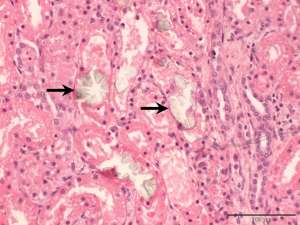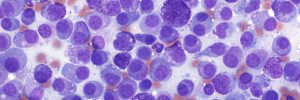Acute renal failure in a cat
A 12-month-old male DSH cat was diagnosed with acute renal failure and subsequently died despite intensive symptomatic treatment. Sections of kidney were collected at post-mortem examination for histopathology. Gross findings consisted of bilateral renomegaly in the absence of any nodular infiltrate.

Final Diagnosis
Acute renal tubular degeneration associated with intratubular crystals
Discussion
The morphology of the crystals is typical for calcium oxalate. The most common cause for these findings in a cat is ethylene glycol (EG) toxicity. EG is most commonly found in antifreeze products and cats are particularly sensitive to intoxication. Although rare, a differential to consider in a young cat such as this is primary hyperoxaluria (a genetic disorder of oxalate metabolism).

